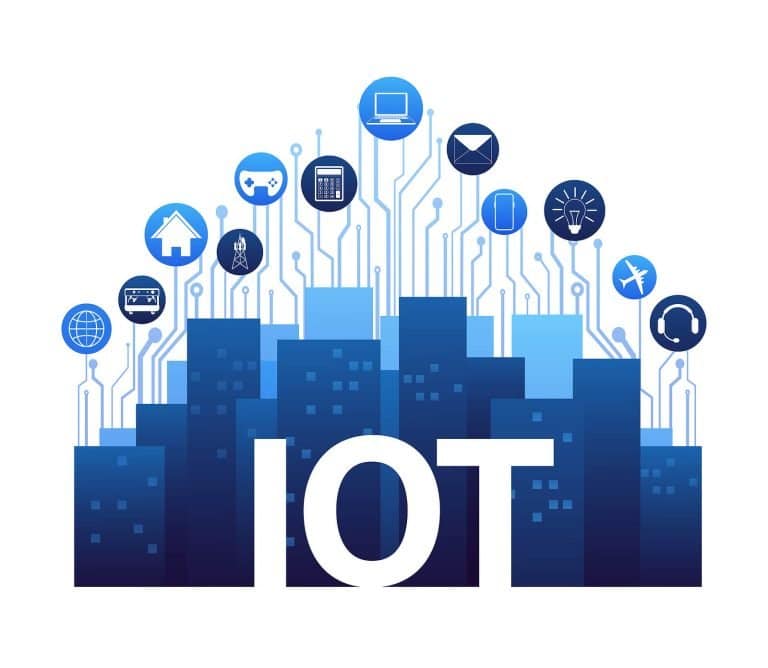Companies have a lot of questions about setting up an in-house IoT solution. Whether it is a matter of wondering what the added value, reliability, or cost will be in the long term, there are many expectations and feedback. However, VSEs, SMEs, and other industries daily adopt an IoT solution to meet specific needs.
Table of Contents
ToggleThe IoT is already a tangible reality.
With over 55 billion objects connected to the Internet by 2025, the IoT represents an essential growth lever for small and multinational businesses.
Multiple daily objects hitherto inert will be able to communicate thanks to installing sensors connected to the Internet, most often using specific SIM cards.
This results in many new uses in fields as diverse as industry, health, logistics, mobility, etc. All business sectors are impacted by this IoT revolution, which also aims to facilitate decision-making in multiple areas (intelligent diagnostics, predictive maintenance, asset optimization, etc.).
This forms a whole that will allow economies of scale, productivity gains, securing external personnel, etc.
Sensors and objects become one.
Sensors are essential to the operation of the IoT. They are grafted onto everyday objects to add a technological layer capable of collecting data (temperature, pressure, GPS coordinates, etc.). The sensors then send the information back via the Internet.
In other words, the IoT brings intelligence to any object to optimize its use. An innovation such as NB-IoT makes it possible to use self-powered communicating sensors that can be screwed or taped onto any material.
Information processing at the heart of the IoT
Companies using IoT solutions receive the information emitted by the sensors via the high-speed Internet.
Depending on the nature of the notification, they can perform predictive maintenance to anticipate future breakdowns, optimize their logistics, production process, etc. The possibilities offered by the IoT are incredibly vast.
Predictive maintenance, a pillar of factory 4.0
Large industrial firms suffer an annual loss of 323 hours of production directly linked to unplanned machine downtime, for an average hourly cost of 450,000 euros. Of course, smaller industrial companies are also affected by this problem.
The extent of this phenomenon is easy to explain; until now, in factories, maintenance was mainly carried out reactively to respond to a problem encountered on the production line. Today, the IIoT allows these companies to perform predictive maintenance.
Predictive maintenance relies on connected sensors installed on the various machines in the plant to anticipate future failures. Temperature, operating time, and rotational speed are the three indicators most measured by factories.
It is thus possible to identify the beginning of overheating of equipment or an anomaly in the operation of a machine to resolve the problem and continue production usually quickly.
For example, Schwering & Hasse produces 140,000 kilometers of copper wire per day in Germany. Its 400 production lines are equipped with 20 connected sensors that record 50,000 events per second in the Iot Project.
Each wire’s temperature, voltage, thermal conductivity, or thickness are analyzed in real-time to prevent all types of possible malfunctions.
The benefits of predictive maintenance are multiple. First, according to a McKinsey study, it halves the number of breakdowns.
This study also shows that predictive maintenance reduces maintenance costs by 10 to 40%. It makes it possible to increase the lifespan of machines, and reduce the need for spare parts and human intervention, etc. Anticipating malfunctions also reduces the risks for people working in the plant.
Predictive maintenance, therefore, allows companies to considerably reduce their costs while increasing the performance of the industrial process.
IoT: multiple daily uses
All business sectors are impacted by the increasing digitization of the world and the arrival of the IoT. Companies still need to appropriate these new technologies and manage to benefit from the new uses that result from them.
Uses that represent gigantic sources of growth in the years to come. They are within reach of all types of companies and all possible and imaginable sectors. Here are a few key examples:
1. Know where your tractor fleet is
Logistics has everything to gain from the Internet of Things, especially with the deployment of 5G. A carrier can know where his pallets, fleet of vehicles, and other packages are in real-time.
This is, for example, the case of an agricultural cooperative that needs to know precisely where its tractors are, which are shared between farmers on various plots.
This operational visibility enables it to optimize its processes. Loans, itineraries, and use time are thus optimized, generating significant energy savings.
2. Optimize the use of hydroalcoholic gel terminals
Hydroalcoholic gel terminals are essential in combating the spread of COVID-19 in public places and businesses.
The Pyrescom company has designed connected terminals capable of individually delivering 35,000 doses. The sensors grafted onto the terminals indicate when they are soon out of amounts, thus making it possible to anticipate their recharging.
They also deliver a real-time view of the doses given to optimize the positioning of terminals, inventory management, and maintenance operations.
3. Intervene in the event of an accident
Lone workers’ safety can be improved through IoT. How do you know if an employee working on a remote site presenting a danger is the victim of an accident or not?
If it evolves on a scale, a box will calculate the loss of verticality and immobility, as well as the GPS point. In the event of a fall, one can imagine a manual or automatic alert trigger button. This type of solution can apply to workers and the elderly.
4. Alert if the threshold is exceeded
The industry has everything to gain from employing IoT solutions. In terms of industrial boilers, for example, the addition of a temperature or pressure sensor associated with a specific SIM card will make it possible to collect valuable real-time information on these materials’ behavior.
In the event of a malfunction (or even hacking), when for example, the pressure exceeds a certain threshold, the sensor will trigger an alert.
The company can lower the pressure remotely thanks to near real-time data processing and schedule a maintenance operation.
The purpose of the IoT is neither the sensor nor the object as such, but the combination of the two and the use that a company will be able to derive from it.
Namely, multiple significant gains: improved customer service, preservation of employee safety, economies of scale, and increased company productivity.
5. Reduce the energy consumption of intelligent cities
Smart cities use the potential of new technologies, including the IoT, to improve the quality of life of city dwellers. For example, the use of sensors connected to lampposts makes it possible to optimize public lighting. The sidewalks can thus be illuminated only in the event of the detection of passers-by. Streetlights adapt the intensity of their lighting to natural light. The sensors, therefore, make it possible to achieve valuable energy savings.




